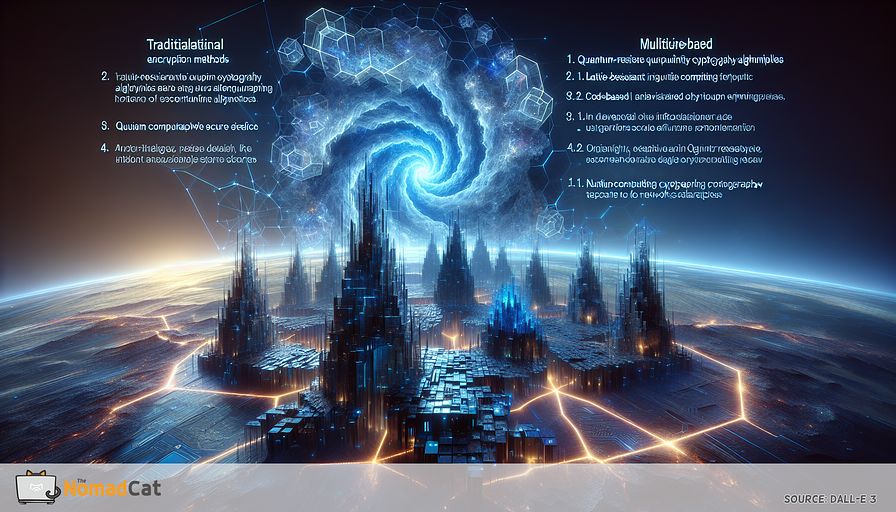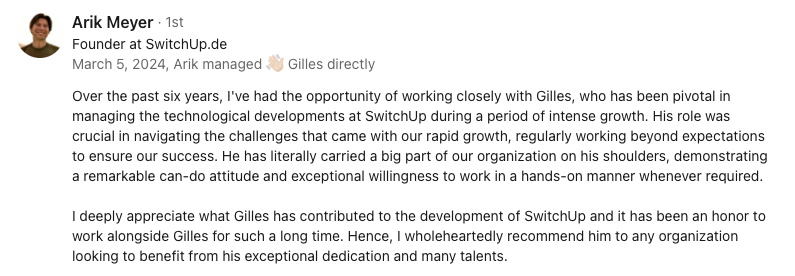The Impact of Quantum Computing on Cybersecurity Strategies
Abstract:
Quantum computing presents a major cybersecurity threat due to its ability to compromise current encryption methods with its unprecedented processing power. To address this, CTOs must consider quantum resistant cryptography, such as lattice-based, code-based, multivariate, and hash-based algorithms, which are secure against classical and quantum computers. Embracing these new encryption methods involves not only adopting the algorithms but also necessitates a shift in cybersecurity strategy, including hardware updates, network architecture rearrangement, and new software integration. CTOs should collaborate with technology and engineering directors to proactively integrate these algorithms and protect sensitive data from evolving threats, ensuring their organization remains competitive and secure.
introduction to quantum computing and its potential threats
Alright, let's talk quantum computing. Imagine your average computer is a high school sprinter. Happy to do one thing at a time. Now, quantum computers are like Olympic-level decathletes—capable of tackling ten things simultaneously, and much faster! The engine driving this magic? The quirky behaviors of particles at quantum scales, which allow quantum computers to process data in ways that leave classical computers eating dust.
You might be wondering, "Sounds great, but what's the catch?" Well, as a Chief Technology Officer, I lose sleep over the cybersecurity threats these devices pose. A leading voice in the field, John Preskill, once quipped, "Quantum computers don’t just push computing forward; they can potentially turn our cybersecurity systems on their heads." And he’s right.
The major concern is that these powerful machines could make our current encryption methods look like paper shields against a hurricane. Encryption algorithms like RSA and ECC, which are the bedrock of modern cybersecurity, could be easily broken by a sufficiently advanced quantum computer. What we once considered uncrackable could be solved in minutes, exposing sensitive data to all and sundry.
So, while quantum computing holds the promise of remarkable technological advancements, it also introduces significant vulnerabilities—imagine finding out your bank vault is made of swiss cheese! We need to be proactive about rethinking our cybersecurity strategies before these quantum juggernauts become mainstream.
Ready to dive into the world where tomorrow's tech threatens today's security? Let's explore the fascinating and somewhat troubling intersection of quantum computing and cybersecurity.
current encryption methods at risk
Before we can truly understand the quantum threat, we need to take a closer look at the encryption methods guarding our sensitive data today. Largely, we rely on RSA (Rivest–Shamir–Adleman) and AES (Advanced Encryption Standard) as our knights in shining armor. These systems are the lifeblood of secure online communication—think bank transactions, confidential emails, and even your cheeky Amazon purchases.
RSA relies on the difficulty of factoring large prime numbers—a tough nut for classical computers to crack. Likewise, AES uses substitution-permutation networks to create complex encryption keys. To us, these methods resemble the prat in class whose homework you could never copy because it looked like glyphs from ancient literature.
However, here’s the zinger: quantum computing is gearing up to ruffle some feathers. Take Shor's algorithm, for instance. This quantum algorithm can factor large numbers with absurd efficiency, giving RSA encryption the chills. And while AES isn't tottering yet, Grover's algorithm promises to reduce the time it takes to brute-force attack AES keys significantly.
These encryption giants may soon look like paper shields against a windstorm. The security protocols we trust today could be torn asunder, leaving critical information as exposed as an overdue library book. It's a compelling reminder that our current fortress might be moments away from a substantial breach as quantum technology continues to evolve.
In essence, the cryptographic methods we've banked on aren't as impervious as we'd hoped. We need to stay ahead of the curve and anticipate the next echelon of cybersecurity measures.
quantum-resistant cryptography
Now, let's get to the nitty-gritty of how we can fend off those quantum gremlins. Welcome to the world of quantum-resistant cryptography. Imagine this as our upgraded, futuristic security system that even the most advanced quantum computers would find tough to crack. Unlike traditional encryption methods, quantum-resistant algorithms aim to provide security against both classical and quantum attacks.
lattice-based algorithms
Lattice-based cryptography is like building your security system on a convoluted labyrinth. These algorithms rely on the mathematical hardness of lattice problems, such as the Learning With Errors (LWE) problem. Picture a needle in a haystack, only it's an infinitely small needle in a haystack that's expanding exponentially. An example is the Kyber algorithm, which has gained attention for its robustness and efficiency. Lattice-based cryptography stands resilient, offering potential resistance to quantum decryption attempts.
code-based algorithms
Next up, we have code-based cryptography. This family of algorithms builds security through the use of error-correcting codes. Think of it as encoding messages with secret codes and then scattering errors throughout, making it extremely difficult for unauthorized parties to decode. The McEliece cryptosystem is a notable example, designed to withstand quantum attacks while being relatively efficient in classical terms. It's like sending messages through an intricate series of locked boxes—very hard to intercept.
multivariate polynomial algorithms
Moving on, let’s consider multivariate polynomial cryptography. This approach uses multivariate quadratic equations as the trapdoor for encryption and decryption. Imagine the equations as a maze so complex that even a quantum Houdini would struggle to escape. Algorithms like Rainbow fall under this category, utilizing the complexity of solving systems of polynomial equations, proving effective against both classical and quantum threats.
hash-based algorithms
Last but certainly not least, hash-based cryptography depends on the security of hash functions. This method is like having a password so complicated that guessing it would take an eternity. The hash-based signature scheme, known as XMSS (eXtended Merkle Signature Scheme), is designed to be quantum-resistant. Hash-based cryptography doesn’t rely on the complexity of mathematical problems but rather the irreversible nature of hash functions, giving us another layer of resilient security.
These quantum-resistant algorithms represent the cutting edge in our ongoing quest to secure data against ever-evolving computational threats. By leveraging these advanced techniques, we can maintain robust cybersecurity defenses and ensure that sensitive information remains locked away, safe from both classical and quantum adversaries.
strategy shift in cybersecurity
Adopting quantum-resistant cryptography is not just a tweak to our cybersecurity protocols—it’s more like a massive overhaul. Picture trading your old bicycle for a state-of-the-art, titanium-frame mountain bike. Sure, the ride might be smoother, but you'll need some time adjusting to all the new gears and brakes. Similarly, quantum-resistant encryption shifts the very foundation upon which our current systems operate.
The first point of impact is the hardware. The chips and processors designed to handle traditional encryption might struggle or outright fail to manage the more complex operations required for quantum-resistant algorithms. This means a substantial investment in upgrading or even replacing current hardware. Imagine swapping out a fleet of hatchbacks for high-performance sports cars—you'll need a different fuel, and oh boy, the mechanics are going to have a field day.
Next, network architecture will need a serious revamp. Transitioning to new cryptographic methods won’t happen in a vacuum. Network elements like routers, firewalls, and endpoints must be reconfigured or replaced to support the additional computational demands. It's a bit like widening a highway; all the little feeder roads and exit ramps need adjustments too.
The software systems we rely on everyday—enterprise solutions, cloud services, and even that humble email client—will require extensive updates. Some might need complete rewrites to accommodate the quantum-resistant cryptographic protocols. Think of the amount of spaghetti code you’ll have to untangle and translate into a new, more security-focused dialect. And let's not forget the hordes of testing that follows.
Organizations need to be proactive, not reactive. Waiting until the quantum threat is on your doorstep is like waiting for your roof to leak before checking for holes. Work out your upgrade strategies early, conduct pilots in controlled environments, and engage in rigorous stress testing. It's akin to preparing for a marathon; you can't just wake up one day and run 26 miles without training.
Consider how some major financial institutions have started already. They are piloting quantum-resistant technologies as part of their long-term strategy, ensuring that their kings of encryption don’t become paupers overnight. Sure, it's expensive and effort-intensive, but in the end, secure customer data is priceless.
The shift to quantum-resistant cryptography is complex and daunting, but I see it as a necessary investment in future security. It may take a village, or rather an IT department the size of a small village, but trust me, it's worth every byte.
role of ctos and collaboration with directors
It's one thing to dream up quantum-resistant cryptography; it’s quite another to implement it. That's where I, as the CTO, come into play, but I’m not alone in this mission. Directors of technology and engineering are my invaluable partners in crime (the good kind). Together, we have to orchestrate a shift that’s both strategic and operational, ensuring our organization isn’t left in the cybersecurity dust.
First off, I need to champion the cause. Convincing the board that substantial investment in new systems is indispensable is no small feat. Think of it as pitching them the latest tech gadget but with stakes much higher than pre-order bragging rights. We need comprehensive budgets covering everything from R&D to workforce training because a half-hearted approach is as good as no approach at all.
cross-functional communication
- Regular meetings with directors to align goals and strategies.
- Workshops and seminars for team members to understand quantum risks and solutions.
- Encouraging a feedback loop to continuously improve our implementation tactics.
Moreover, collaboration with directors ensures that all technical facets—from hardware swaps to software updates—are cohesively managed. Imagine planning a surprise party but forgetting the cake; everything needs to sync perfectly. They keep the engine running smoothly while I steer us in the right direction.
The directors also relay critical insights from ground-zero. If there's a snag in the deployment process, they’re the first to know and inform me. This mutual feedback system lets us pivot quickly, ensuring minimal disruption. After all, nobody wants to hear that the firewall supporting quantum-resistant encryption can't handle the traffic load!
It’s safe to say that the task is hefty, but with the right synergy among senior leaders, we can navigate these complex waters adeptly. Remember, unified leadership isn't just a nice-to-have; it's the secret sauce to getting things right when it matters most.
challenges in implementation
Implementing quantum-resistant cryptography isn't exactly a stroll in the park. There’s a laundry list of challenges that organizations encounter, each demanding a strategic approach. So, let’s put on our problem-solving hats and delve into some of the key obstacles.
cost considerations
First, there’s the cost. Upgrading to quantum-resistant cryptographic systems involves a significant financial investment. We're not talking pocket change; budgets must cover hardware upgrades, new software licenses, and extensive R&D. According to a tech report I recently read, "Anticipate budget overruns if you want to do this right." That’s industry-speak for "Start saving now because this is going to be pricey."
specialized training
Next up is the need for specialized training. Implementing these advanced systems requires a workforce that's well-versed in quantum mechanics, cryptography, and IT infrastructure. Finding people with these skills is like hunting for unicorns. We might need to roll out comprehensive training programs, which means setting aside more time and resources. Picture it like going back to college, but this time you’re learning about quantum key distribution instead of Philosophy 101.
deployment timeline complications
Don’t even get me started on deployment timelines. These projects can take months, if not years, to roll out. That’s if everything goes perfectly smoothly, which, let’s face it, never happens. The timeline extends when dealing with technical snags, compatibility issues, and unforeseen hiccups. As one industry veteran put it, "Implementing quantum-resistant cryptography is like building an airplane while flying it."
overcoming obstacles
So how do we tackle these challenges head-on? A blend of strategic foresight and practical actions can make a difference. For starters:
- Phased rollouts: Implement quantum-resistant systems in stages to manage costs and complexity better.
- Continuous education: Invest in training programs and certifications to upskill your current workforce.
- Collaborate with experts: Work with academic institutions and industry leaders to gain insights and practical solutions.
With these steps, we can turn these high hurdles into manageable stepping stones. It's daunting, but with meticulous planning and collaborative effort, we can overcome even the most formidable barriers.
future-proofing against quantum threats
Staying ahead of the quantum curve isn't just about swapping out algorithms today; it's about **continuous vigilance and adaptation**. We can't afford to rest on our laurels once we implement quantum-resistant cryptography. Just like you wouldn’t stop updating your antivirus software, our cyber defenses need constant refreshing to counteract emerging quantum threats.
To maintain our edge, we need to adopt a forward-looking approach. Always keep an eye on **emerging technologies** and trends in the cybersecurity landscape. It’s like watching a suspense thriller—you never know what's around the corner, but you want to be ready for anything. Keep in mind that quantum capabilities are advancing swiftly, and today's cutting-edge solutions might be tomorrow's relics.
key strategies for staying agile
- Regular audits and updates: Conduct frequent security reviews and algorithm updates to ensure that your systems aren’t left vulnerable to new developments.
- Collaborative research: Partner with academic institutions, industry leaders, and cybersecurity consortiums to stay informed and share knowledge.
- Flexible architecture: Design your cybersecurity infrastructure to be adaptable, allowing for quick pivots when new quantum threats emerge.
- Employee education: Continuously train your workforce to recognize and mitigate new types of threats.
Adopting these strategies can bolster our resilience against an evolving threat landscape. As Cisco's CEO, Chuck Robbins, aptly noted, "Security is a journey, not a destination." It's our job to stay proactive and ready for the unexpected. **Future-proofing** isn't just a one-time effort; it's an ongoing mission. So, let's keep our guard up and our systems locked tight, ensuring we’re always one quantum leap ahead.
final thoughts
After navigating the high seas of quantum computing and its potential cybersecurity implications, a few things stand out clearly. Quantum computing is set to revolutionize the computing landscape, but it's also a double-edged sword that can turn our trusted encryption methods into Swiss cheese. Our RSA and AES fortresses, once deemed impregnable, now face significant threats from quantum algorithms like Shor’s and Grover’s.
In this context, quantum-resistant cryptography emerges as our knight in shining armor. Technologies like lattice-based, code-based, multivariate polynomial, and hash-based algorithms show promise in standing firm against quantum onslaughts. But the journey to implement these advanced cryptographic methods is filled with challenges, ranging from high costs and specialized training needs to complex deployment timelines. As they say, no pain, no gain.
Here's the takeaway: It's essential to remain vigilant and proactive in your cybersecurity strategies. Regular audits, collaborative research, flexible architectures, and continuous workforce education aren't just good practices—they’re necessities. As Chuck Robbins from Cisco wisely put it, "Security is a journey, not a destination." Let's keep evolving, stay informed, and ensure our defenses remain robust against quantum threats.
So, let's roll up our sleeves and get to work. The future of cybersecurity hinges on our ability to adapt and outsmart these quantum juggernauts. Together, we can ensure that our digital fortresses remain secure, no matter what the quantum future holds.
You might be interested by these articles:
- Revolutionizing Tech with Quantum Computing
- Quantum Computing's Next Leap
- Securing Talent in Europe's Quantum Revolution





